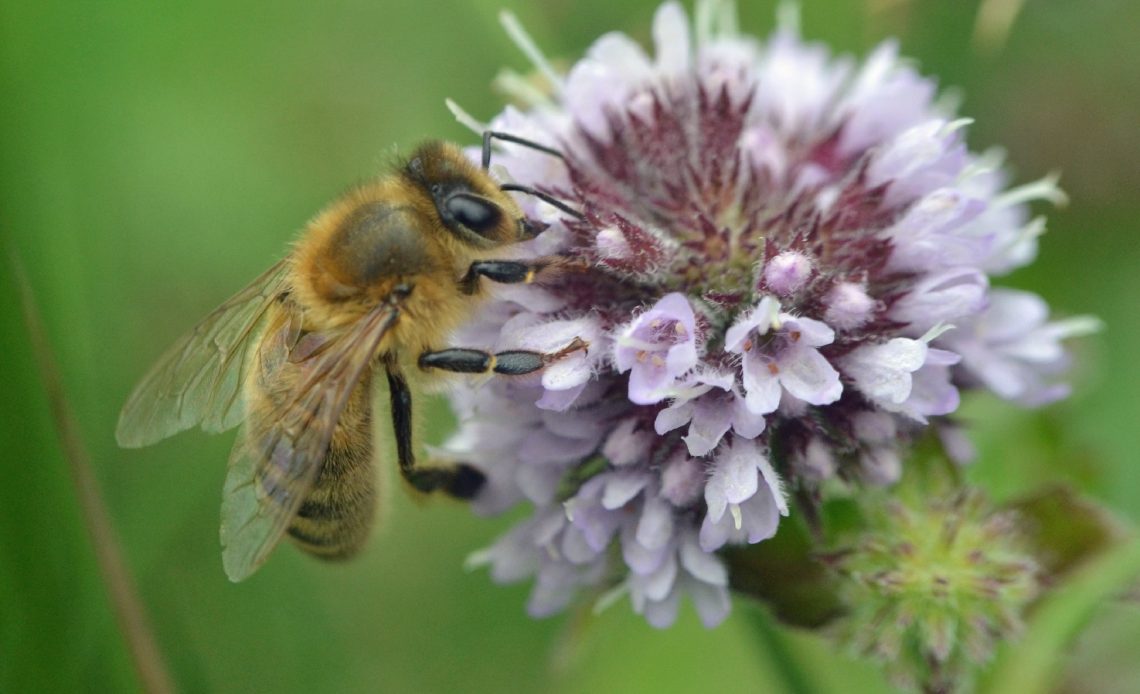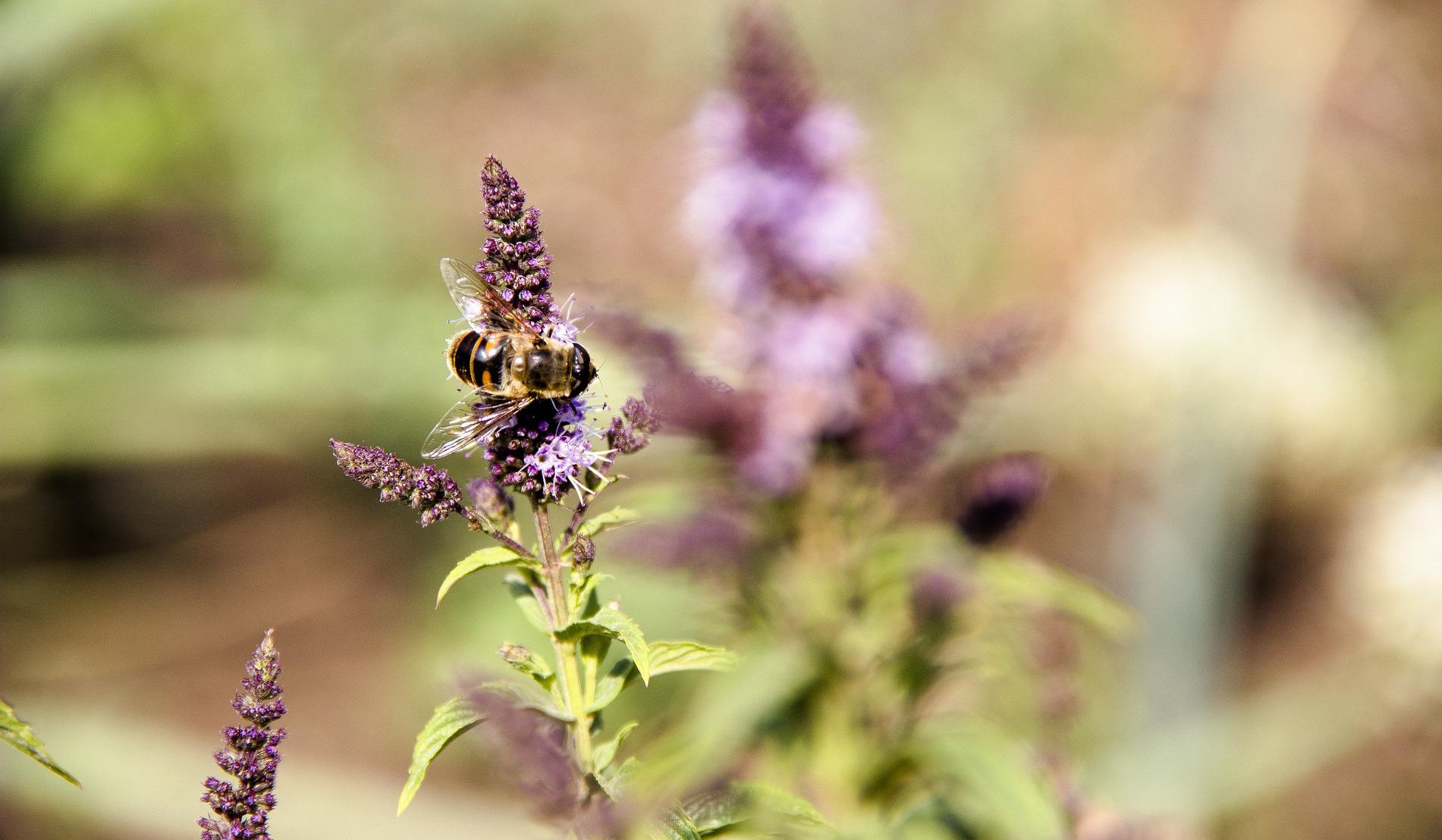

We’re here to help! Wild Yards is a completely free website that is 100% dedicated to helping you create a wildlife-friendly, sustainable yard. Read more
WildYards is reader-supported. When you buy a product through a link on our site, we may earn a comission. Every product is independently selected by our (obsessive) editors and our reviews are unbiased and objective. Read more about our mission or our privacy policy.
A fresh sprig of mint can dress up any dish. It’s just as tasty on a savory leg of lamb as it is in a bowl of vanilla ice cream. This versatile herb is so easy to grow you won’t believe it, which is why it’s such a popular choice for herb gardens. But do insects like mint as much as we do? Do bees like mint?
Yes, bees love mint, and they’re happy to visit any variety. With its small, fragrant flowers, mint is one of their preferred plants. So no matter which type of mint you choose, it can help bring more bees to your backyard!
Why are bees attracted to mint?
Bees need both pollen and nectar to stay healthy. The pollen provides them with protein, and the nectar gives them quick energy, so they can keep visiting flowers. They also use nectar to produce honey so they’re always on the lookout for flowers with a steady supply of both of these things.
Of course, just because a flower has a lot of pollen and nectar doesn’t necessarily mean that bees will be attracted to it. Red flowers are rarely a hit with bees because they have trouble seeing that color. And long, narrow, trumpet-shaped flowers, like some varieties of honeysuckle, are less likely to attract bees because they can’t fit into the blooms to reach the nectar.
What bees need is flowers that have plenty of pollen, and a store of nectar that’s easy for them to get to. Mint is just the ticket! This herb’s flowers are small and shallow, so it’s easy for bees to reach the nectar.
Additionally, mint plants produce many clusters of flowers. That means bees can stay in one place and pollinate for a long time. Even though bees can fly for miles in search of food (they have the potential to fly thousands of feet up in the air!) they prefer not to fly around too much. Mint gives those busy bees a chance to rest.
What kinds of bees are attracted to mint?
Mint can attract all kinds of bees, but it’s especially popular with honey bees. Unlike bumblebees, honey bees have small proboscises, which are the straw-like tongues bees and other pollinating insects use to collect nectar. Mint flowers have larger openings, and that makes it easy for honey bees to collect their nectar.
Mint is so attractive to honey bees that many beekeepers grow it near their hive boxes to help with honey production. Bees prefer mint over other plants, including chamomile and cinnamon. So not only do bees like mint because the nectar is so easy to get to but they love the taste as well!
It is worth noting that bees are only attracted to mint flowers, not the mint plant itself. Paradoxically, when it’s not in bloom, mint repels bees. So if you want to use your mint to keep bees away, be sure to cut the flowers back before they bloom.

Which type of mint should you plant in your bee garden?
Bees love all kinds of mint! Whether you decide to plant a classic cultivar, like spearmint or peppermint, or something a little more exciting, like chocolate mint or banana mint, you can’t go wrong. Your local bees will be happy with whichever varieties you choose.
While the type of mint you grow doesn’t matter, there are a couple of things you need to consider if you want to use mint to attract bees to your yard. First, you need to assess your yard’s growing conditions. And, second, you’ll need to consider the plant’s needs.
Mint is invasive. Once you plant it, it can be incredibly difficult to get rid of. If your goal is to rewild your backyard space, then feel free to let your mint “grow” wild. But, if want to restrain your mint, your best bet is to grow it in a large pot with a few drainage holes on the bottom.
Another reason to consider growing mint in pots is if you have poor soil. Mint prefers nutrient-rich soil that’s not too acidic. The soil should be well-drained but kept moist. And, whether you grow your mint in pots or in the ground, it should be in a place that receives partial sun.
Some types of mint can tolerate full sun in the northern portion of the U.S. But, if you live in a southern state, the summer temperatures may be more than your mint can bear. So keep it in a place where it gets morning sun, but is protected from the harsh afternoon rays.
If your backyard tends to stay wet and soggy, or if you have a pond that you want to bring more wildlife to, consider water mint. Not only does this plant attract bees and other pollinating insects, but it also helps keep mice and flies away!
Which herbs can you plant with mint to attract bees to your garden?
A successful bee garden is one that provides bees with blooming flowers month after month from spring to fall. Of course, not many plants bloom for six months at a time. So you have to stagger the blooming periods of multiple plants to give your bees a steady supply of food.
Start the pollinating season with lavender. This herb begins blooming early in May and sticks around until June or July. When your lavender flowers start to fade, leave it to your mint plants to take over. Mint blooms from June to September, during a time when many flowers have already bloomed, and other blooms have yet to open up.
Adding plenty of mint to your bee garden increases availability, and that will grab the bees’ attention. As the season progresses, the size of the mint flowers decreases. And, interestingly, this is directly correlated to the size of the bees that pollinate them. They get smaller, too!
As the summer season starts winding down, your local bees’ demand for food goes up. Garlic chives, oregano, and rosemary are popular choices for fall herb gardens. Their fragrant flowers will help your bees get ready for the winter when most bees hibernate.
Adding mint to your backyard patio is one of the fastest ways to get native bees interested in your garden. By growing mint in sequence with a variety of other herbs, you can ensure your neighborhood hive has plenty of flowers to forage during the pollinating season!
